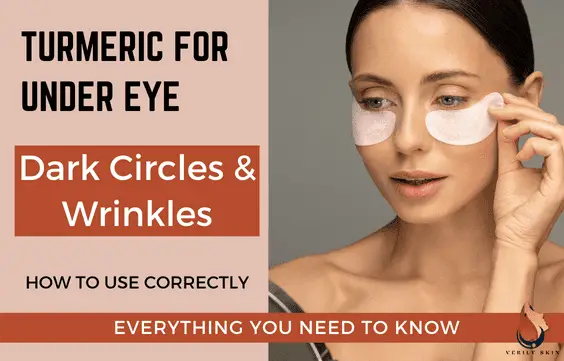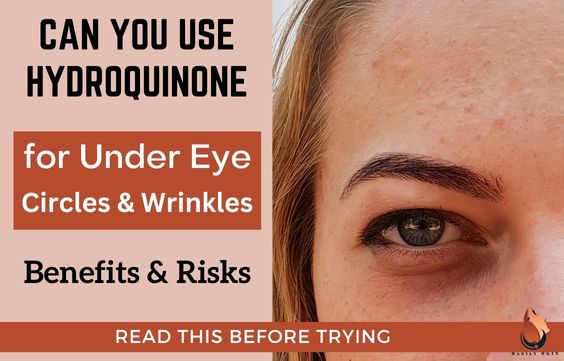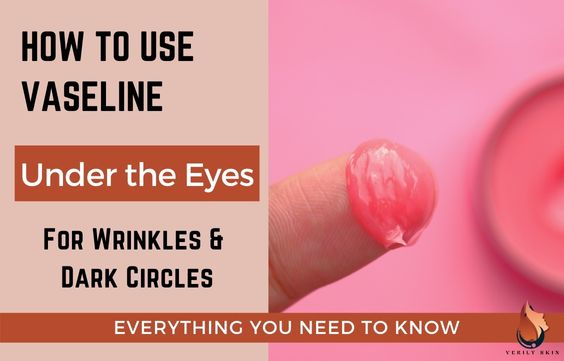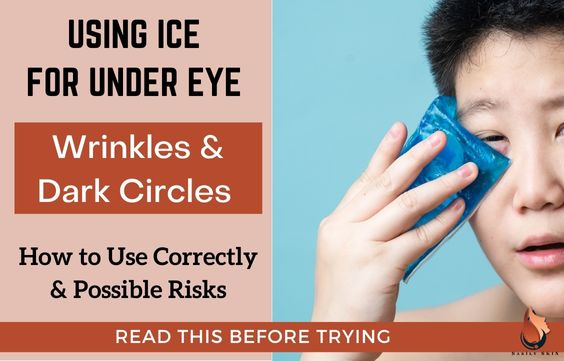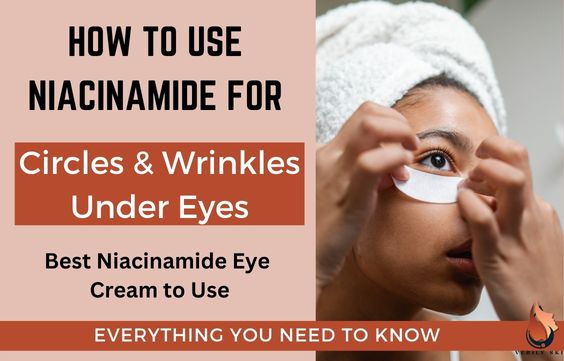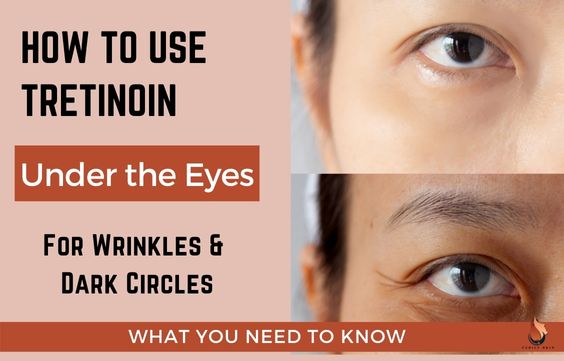Using Azelaic Acid for Wrinkles & Circles Under the Eyes
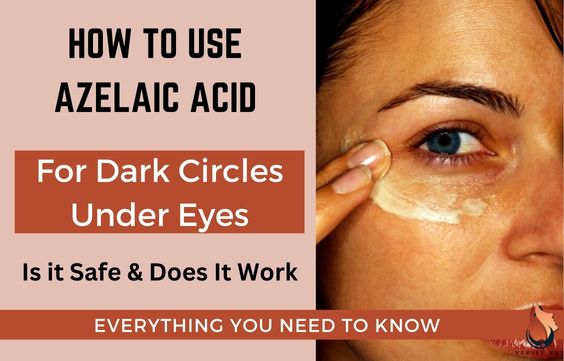
Azelaic acid is much gentler than other acids. But is it gentle enough to be used for those pesky dark circles under the eyes?
The short answer is yes. However, it will largely depend on your skin’s sensitivity and the concentration of azelaic acid you want to use.
Can You Apply Azelaic Acid Under Your Eyes
Dermatologists say that you can apply azelaic acid under your eyes but in low concentrations and mild formulations.
Azelaic acid is less aggressive than salicylic acid, benzoyl peroxide, or even glycolic acid (in some strengths). However, it can irritate sensitive skin if used incorrectly.
Remember that the skin under your eyes is very thin and sensitive, and very close to your eyeballs. So you want to stay away from very aggressive ingredients.
However, if used in a suitable concentration and formulation for your skin, you can safely use it under your eyes.
Other alternatives you can use for your under eyes are;
Niacinamide for Dark Spots & Wrinkles Under the Eyes
Chamomile Tea Bags On Eyes: Benefits & How To Use – For a very gentle and natural method.
Toothpaste For Dark Under-Eye Circles & Wrinkles
How to use Honey for Under Eye Wrinkles & Dark Circles
Will Azelaic Acid Lighten Dark Circles Under The Eyes
Yes. Azelaic Acid inhibits the production of melanin in the skin so it will lighten under eye dark circles over time.
Azelaic Acid works by inhibiting tyrosinase, which is the enzyme that regulates melanin (the dark pigment) production in the skin.
It also unclogs your pores and speeds up skin cell turnover and exfoliation, making the skin gradually more even-toned
Tretinoin For Under Eye Circles & Wrinkles: What to Know
Witch Hazel for Under Eyes- Dark Circles, Bags & Puffiness
Can You Use Hydroquinone for Under-Eye Circles & Wrinkles
Does Azelaic Acid Help With Wrinkles Under The Eyes
There is no evidence to suggest that azelaic acid directly treats wrinkles. However, its exfoliating properties may help by evening out skin texture and tone.
Azelaic acid is not known to have anti-wrinkle properties. However, it does exfoliate the skin.
When skin cells are turned over, collagen production is also increased. This will tighten the skin under the eyes while the exfoliation evens out the surface texture.
Other great natural ways to lighten dark circles are:
Using Potatoes For Under-Eye Dark Circles & Wrinkles
Cucumbers On Eyes: Benefits & Side Effects- What to Know
How to Use Turmeric for Under Eye Dark Circles & Wrinkles
Milk to Treat Dark Circles: Will it Work & How to Use
How To Use Azelaic Acid To Lighten Dark Circles Under The Eyes
The safest way to use azelaic acid to lighten your dark under the eyes is as an eye cream. Or, you can mix a serum with a hydrating eye cream.
Generally, prescription-strength azelaic acid (15%-20%) will be too strong for the under-eye area. Therefore, prescription topical creams might not be a good idea unless advised by a dermatologist.
Experts recommend using azelaic acid in strengths that are 10% or less for the under-eye area. OTC preparations are not available in anything stronger than 10%.
However, concentrations up to 10% should be more than adequate to treat under eye dark circles. The skin there is thin and will more readily absorb the product.
You should also be sure to use it in a hydrating formulation. This will prevent dryness and irritation. Look for the ones that also have hyaluronic acid, niacinamide, and ceramides. These ingredients help to nourish and maintain the skin’s moisture barrier.
Related Articles –
How to Use Vitamin C for Under Eye Circles & Wrinkles
Essential oils for Under-Eye: Puffy Circles & Wrinkles
Can you use Salicylic Acid Under the Eyes – Shocking Truth
Lemon for Under-Eye Circles & Wrinkles – Benefits & Risks
How Long Should You Leave Azelaic Acid On The Skin Under Your Eyes
When used correctly, azelaic acid can be safely left on the under-eye area all day or all night.
This will depend on your skin and the formulation.
Most eye creams with azelaic acid are also hydrating. This means that it will not irritate the skin if left on. Azelaic acid also generally reacts well with almost any other product and makeup. Therefore, skincare ingredients, if required, can be layered over it.
The determining factors will be how sensitive the skin under your eyes is, and the formulation of the product.
Always remember to patch-test the product first. You may also start by using it a few times a week. Build up the frequency so that your skin will gradually become accustomed to it.
To explore your options to lighten dark circles check out my article on The 10 Best Medical & Home Remedies For Under Eye Dark Circles
How to use Vaseline for Wrinkles & Circles Under the Eyes
How Often Should You Use Azelaic Acid For Dark Circles Under The Eyes
Azelaic acid can and should be used once or twice daily until your dark circles have disappeared.
This may vary depending on how your skin tolerates the product but azelaic acid eye creams are usually well tolerated.
If you notice dryness or irritation, you may cut down the frequency to once per day, or every other day.
It will still clear up your dark circles but it will take a little longer.
Using Ice For Under-Eye Circles: Is it Safe, Pros & Cons
Risks Of Using Azelaic Acid Under The Eyes
The most common risks of using azelaic acid under the eyes are irritation and getting it in your eyes.
Irritating the under eye area can cause contact dermatitis which can spread to your eyes. If this is bad, it can damage your skin, as well as your eyes.
Additionally, be very careful to avoid getting eye creams and azelaic acid in your eye. If you do, open your eyes in clean, room temperature water. Try and wash them out and seek medical attention afterward.
Another rare risk is the possibility of being allergic to azelaic acid. However, you should still watch your skin for signs of an allergic reaction.
Observe your skin. See if your under eyes will start to swell, burn, look red and angry, develop hives, peel or become itchy. If they do, wash your skin off with clean water (avoid the eyes themselves) and seek medical attention.
If you start to feel dizzy, short of breath, or lightheaded, these could be signs of a more severe reaction. Stop using the product, call 911 immediately or go to your nearest emergency care provider.
Recommended Azelaic Acid Products For Dark Circles Under The Eyes
1- Azelique Age Refining Eye Treatment
This eye cream was specially created for the under eyes to balance darkness, reduce puffiness, and maintain hydration.
It contains azelaic acid, hyaluronic acid, caffeine, Pichia/Resveratrol Ferment, botanical extracts, and glycolic acid. It is gentle and suitable for all skin types.
Click here to see the price for the Azelique Age Refining Eye Treatment on Amazon.
2- Paula’s Choice 10% Azelaic Acid Booster Cream Gel
This is a combination of azelaic acid, a minute amount of salicylic acid (0.5%), and natural brightening and calming components. It treats obstinate acne scars and dark spots at once.
The oil-free, lightweight texture is wonderful on its own or it can be combined with an eye cream.
Click here to check out the Paula’s Choice 10% Azelaic Acid Booster Cream Gel on Amazon.
3- Naturium Azelaic Topical Acid 10%
This serum has a high concentration of azelaic acid, niacinamide, vitamin C, and coffee seed extract.
It works to reduce other visible skin flaws including congestion, dullness, and discoloration. This can be combined with a hydrating eye cream to be used under the eyes.
Click here to see the Naturium Azelaic Topical Acid 10% on Amazon.
Related Article:
How To Correctly Moisturize When Using Azelaic Acid
Sources:
Dark circles under the eyes: Causes and treatments
The Best Skin Care Products For Dark Circles, According To Dermatologists | HuffPost Life
5 best azelaic acid products of 2022, according to dermatologists

